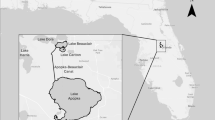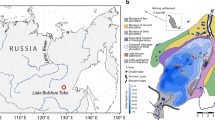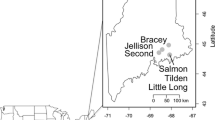Abstract
Lake Geneserath is located on Beaver Island in northern Lake Michigan, USA. It exhibits evidence of recent eutrophication, despite limited anthropogenic activity in the watershed. The primary goal of this study was to determine the time scale of trophic state change in Lake Geneserath and the influence of multiple stressors. Sediment cores from the shallow northern and deep southern basins of Lake Geneserath were collected and sectioned at 0.5-cm intervals over the topmost 10 cm and at 1.0-cm intervals for the remainder of the core. Total phosphorus, percent organic matter, and chlorophyll derivative concentrations were measured in each section, and core chronology was established using 210Pb. Diatom assemblages were quantified from evenly distributed sections in each core. Geochemical variables in the southern basin core indicate historic (AD ~ 1450–1650) and modern (1848-present) periods of eutrophication, coincident with human disturbance and climate warming events. Geochemical variables in the northern basin core confirm accelerating eutrophication after 1950. The fossil diatom assemblages in both basins shifted from species favoring low nutrients to more nutrient-tolerant taxa. A change from periphytic to planktonic diatom species, concurrent with reduced percent organic matter in the northern basin core, indicates rising water level during the second half of the twentieth century. Lake Geneserath was subject to multiple stressors and its trophic status increased with recent residential development and climate warming.





Similar content being viewed by others
References
Agbeti MD, Dickman M (1989) Use of lake fossil diatom assemblages to determine historical changes in trophic status. Can J Fish Aquat Sci 46:1013–1021
Agbeti MD, Kingston JC, Smol JP, Watters C (1997) Comparison of phytoplankton succession in two lakes of different mixing regimes. Arch Hydrobiol 140:37–69
Ahmed M, Anchukaitis KJ, Asrat A, Borgaonkar HP, Braida M, Buckley BM, Büntgen U, Chase BM, Christie DA, Cook ER, Curran MAJ, Diaz HF, Esper J, Fan ZX, Gaire NP, Ge Q, Gergis J, González-Rouco JF, Goosse H, Grab SW, Graham N, Graham R, Grosjean M, Hanhijärvi ST, Kaufman DS, Kiefer T, Kimura K, Korhola AA, Krusic PJ, Lara A, Lézine AM, Ljungqvist FC, Lorrey AM, Luterbacher J, Masson-Delmotte V, McCarroll D, McConnell JR, McKay NP, Morales MS, Moy AD, Mulvaney R, Mundo IA, Nakatsuka T, Nash DJ, Neukom R, Nicholson SE, Oerter H, Palmer JG, Phipps SJ, Prieto MR, Rivera A, Sano M, Severi M, Shanahan TM, Shao X, Shi F, Sigl M, Smerdon JE, Solomina ON, Steig EJ, Stenni B, Thamban M, Trouet V, Turney CSM, Umer M, van Ommen T, Verschuren D, Viau AE, Villalba R, Vinther BM, von Gunten L, Wagner S, Wahl ER, Wanner H, Werner JP, White JWC, Yasue K, Zorita E (2013) Continental-scale temperature availability during the past two millennia. Nat Geosci 6:339–346
APHA (1998) Standard methods for the examination of water and wastewater, 20th edn. American Public Health Assocation, Washington
Appleby PG, Oldfield F (1978) The calculation of Lead-210 dates assuming a constant rate of supply of unsupported 210Pb to the sediment. Catena 5:1–8
Barker PA, Pates JM, Payne RJ, Healey RM (2005) Changing nutrient levels in Grasmere, English Lake District, during recent centuries. Freshw Biol 50:1971–1981
Battarbee RW (1986) Diatom analysis. In: Berglund BE (ed) Handbook of holocene palaeoecology and palaeohydrology. Wiley, New York, pp 527–570
Battarbee RW (2000) Palaeolimnological approaches to climate change, with special regard to the biological record. Quat Sci Rev 19:107–124
Binford MW (1990) Calculation and uncertainty analysis of 210Pb dates for PIRLA project lake sediment cores. J Paleolimnol 3:253–267
Binford MW, Brenner M (1986) Dilution of 210Pb by organic sedimentation in lakes of different trophic states, and application to studies of sediment-water interactions. Limnol Oceanogr 31:584–595
Bradbury JP, Dieterich-Rurup KV (1993) Holocene diatom palaeolimnology of Elk Lake, Minnesota. In: Bradbury JP, Dean WE (eds) Elk Lake, Minnesota: evidence for rapid climate change in the North-central United States. Geol Soc Am Boulder, Colorado, pp 215–237
Bradley RS, Jones PD (1993) Little Ice Age summer temperature variations: their nature and relevance to recent global warming trends. Holocene 3:367–376
Brown DG, Johnson KM, Loveland TR, Theobald DM (2005) Rural land-use trends in the conterminous United States, 1950–2000. Ecol Appl 15:1851–1863
Carpenter SR, Frost TM, Heisey D, Kratz TK (1989) Randomized intervention analysis and the interpretation of whole-ecosystem experiments. Ecology 70:1142–1152
Collar H (1907–1996) Archived papers. Located at Clarke Historical Library, Central Michigan University, Mount Pleasant, Michigan, USA
Collar H (1980) The pre-mormon settlement on Beaver Island, 1837–1852. J Beaver Isl Hist 2:9–28
Dietrich RV (1978) Post-valders geological histroy of Beaver Island, Michigan. Mich Acad 10:283–297
Ekdahl EJ, Teranes JL, Wittkop CA, Stoermer EF, Reavie ED, Smol JP (2007) Diatom assemblage response to Iroquoian and Euro-Canadian eutrophication of Crawford Lake, Ontario, Canada. J Paleolimnol 37:233–246
Engstrom DR, Swain EB, Kingston JC (1985) A palaeolimnological record of human disturbance from Harvey’s Lake, Vermont: geochemistry, pigments, and diatoms. Freshw Biol 15:261–288
Engstrom DR, Schottler SP, Leavitt PR, Havens KE (2006) A reevaluation of the cultural eutrophication of Lake Okeechobee using multiproxy sediment records. Ecol App 16:1194–1206
Fraser GS, Larsen CE, Hester NC (1990) Climatic control of lake levels in the Lake Michigan and Lake Huron basins. Geol S Am S 251:75–90
Fritz SC, Kingston JC, Engstrom DR (1993) Quantitative trophic reconstruction from sedimentary diatom assemblages: a cautionary tale. Freshw Biol 30:1–23
Garrison PJ (2005) Assessment of water quality in Lake Owen, Bayfield County Wisconsin by the use of fossil diatoms. Wisconsin Department of Natural Resources, Bureau of Integrated Science Services, PUB-SS-1014 2005
Glew JR (1989) A new trigger mechanism for sediment samplers. J Paleolimnol 4:241–243
Gorham E, Sanger JE (1976) Fossilized pigments as stratigraphic indicators of cultural eutrophication in Shagawa Lake, northeastern Minnesota. Geol Soc Am Bull 87:1638–1642
Harris MA, Cumming BF, Smol JP (2006) Assessment of recent environmental changes in New Brunswick (Canada) lakes based on paleolimnological shifts in diatom species assemblages. Can J Bot 84:151–163
Hill HL (1991) Tales from the other end of the Island. BookCrafters, Chelsea
Julius MJ, Stoermer EF, Taylor CM, Schelske CL (1998) Local extirpation of Stephanodiscus niagarae (Bacillariophyceae) in the recent limnological record of Lake Ontario. J Phycol 34:766–771
Kingston JC (2003) Araphid and monoraphid diatoms. In: Wehr JD, Sheath RG (eds) Freshwater Algae of North America. Academic Press, Amsterdam, pp 595–636
Krezoski JK, Mozley SC, Robbins JA (1978) Influence of benthic macroinvertebrates on mixing of profundal sediments in southeastern Lake Huron. Limnol Oceanogr 23:1011–1016
LaBeau NS (1967) Preliminary survey of aquatic vascular plants, Beaver Island, Michigan with special reference to Barney’s Lake, Fox Lake, and Lake Geneserath. MS Thesis, Central Michigan University, Mount Pleasant, Michigan, USA
Lami A, Guilizzoni P, Ryves DB, Jones VJ, Marchetto A, Batarbee RW, Belis CA, Bettinetii R, Manca M, Comoli P, Nocentini A, Lagone L (1997) A late glacial and Holocene record of biological and environmental changes from the Crater Lake Albano, Central Italy: an interdisciplinary European project (PALICLAS). Water Air Soil Pollut 99:601–613
Leavitt PR, Hodgson DA (2001) Sedimentary pigments. In: Smol JP, Birks HJB, Last WM (eds) Tracking environmental change using lake sediments, vol 3. Kluwer, Dordrecht, pp 295–325
Leavitt PR, Carpenter SR, Kitchell JF (1989) Whole-lake experiments: the annual record of fossil pigments and zooplankton. Limnol Ocean 34:700–717
Løvstad Ø (1984) Growth limiting factors for Oscillatoria agardhii and diatoms in eutrophic lakes. Oikos 42:185–192
Lowe RL (1974) Environmental requirements and pollution tolerance of freshwater diatoms. United States Environmental Protection Agency, EPA-670/4-74-005
Pappas JL, Stoermer EF (1995) Effects of inorganic nitrogen enrichment on Lake Huron phytoplankton: an experimental study. J Great Lakes Res 21:178–191
Parr J, Taffs KH, Lane CM (2004) A microwave digestion technique for the extraction of fossil diatoms from coastal lake and swamp sediments. J Paleolimnol 31:383–390
Patrick R, Reimer CW (1966) The Diatoms of the United States, exclusive of Alaska and Hawaii, vol. 1. Monographs of the Academy of Natural Sciences of Philadelphia no. 13, Philadelphia, USA
Penskar MR, Hyde DA, Higman PJ, Poskus JJ, Goforth RR, Cuthrell DL, Alber DA, Boehm RL. (2000) Biological inventory for conservation of Great Lakes Islands: 1999 Progress Report. Michigan Natural Features Inventory. Report Number 2000-11
Quinn GP, Keough MJ (2002) Experimental design and data analysis for biologists. Cambridge University, New York
Rakowski BA (1978) Qualitative and quantitative algal phytoplankton and chemical analyses, Lake Geneserath, Beaver Island, Charlevoix County, Michigan. MS Thesis, Central Michigan University, Mount Pleasant, Michigan, USA
Rühland K, Priesnitz A, Smol JP (2003) Paleolimnological evidence from diatoms for recent environmental changes in 50 lakes across Canadian Arctic treeline. Arct Antarct Alp Res 35:110–123
Rühland K, Paterson AM, Smol JP (2008) Hemispheric-scale patterns of climate-related shifts in planktonic diatoms from North American and European lakes. Glob Change Biol 14:2740–2754
Rybak M, Dickman M (1988) Paleoecological reconstruction of changes in the productivity of a small, meromictic lake Southern Ontario, Canada. Hydrobiologia 169:293–306
Sanger JE (1988) Fossil pigments in paleoecology and paleolimnology. Palaeogeog Palaeoclim Palaeoecol 62:343–359
Saros JE, Michel TJ, Interlandi SJ, Wolfe AP (2005) Resource requirements of Asterionella formosa and Fragilaria crotonensis in oligotrophic alpine lakes: implications for recent phytoplankton community reorganizations. Can J Fish Aquat Sci 62:1681–1689
Saros JE, Stone JR, Pederson GT, Slemmons KE, Spanbauer T, Schliep A, Cahl D, Williamson CE, Engstrom DR (2012) Climate-induced changes in lake ecosystem structure inferred from coupled neo- and paleoecological approaches. Ecology 93:2155–2164
Schelske CL, Stoermer EF, Fahnenstiel GL, Haibach M (1986) Phosphorus enrichment, silica utilization, and biogeochemical silica depletion in the Great Lakes. Can J Fish Aquat Sci 43:407–415
Shuman B (2003) Controls on loss-on-ignition variation in cores from two shallow lakes in the northeastern United States. J Paleolimnol 30:371–385
Snucins E, Gunn J (2000) Interannual variation in the thermal structure of clear and colored lakes. Limnol Oceanogr 45:1639–1646
Steinberg CEW, Trumpp M (1993) Palaeolimnological niche characterization with selected algae. I. Planktonic diatoms from a hardwater habitat. Arch Protistenkd 143:249–255
Stoermer EF (1978) Phytoplankton assemblages as indicators of water quality in the Laurentian Great Lakes. Trans Amer Micros Soc 97:2–16
Stoermer EF, Kreis RG (1980) Phytoplankton composition and abundance in southern Lake Huron. US. Environmental Protection Agency, EPA-600/3-80-061
Stoermer ER, Emmert G, Schelske CL (1989) Morphological variation of Stephanodiscus niagarae Ehrenb. (Bacillariophyta) in a Lake Ontario sediment core. J Paleolimnol 2:227–236
Swain EB (1985) Measurement and interpretation of sedimentary pigments. Freshw Biol 15:53–75
Turkia J, Lepistö L (1999) Size variations of planktonic Aulacoseira Thwaites (Diatomae) in water and in sediment from Finnish lakes of varying trophic state. J Plankton Res 21:757–770
Wetzel RG (2001) Limnology: lake and river ecosystems, 3rd edn. Academic Press, San Diego
Wetzel RG, Likens GE (2000) Limnological analyses, 3rd edn. Springer, New York
Wolin JA, Stoermer EF (2005) Response of a Lake Michigan coastal lake to anthropogenic catchment disturbance. J Paleolimnol 33:73–94
Acknowledgments
We thank the generous residents of Lake Geneserath for providing much needed equipment and support, especially D. and M. Cook, D. and R. Benjamin, and J. Wojan. We also thank J. Burke for her thorough review of an early draft of this paper. Fieldwork was conducted at the Central Michigan Biological Station on Beaver Island. This project was supported by a Grants-In-Aid of Research in Phycology from the Phycological Society of America and CMU’s SCRE grant, Raymond E. Hampton Excellence in Biology Endowment, and Daniel E & Mildred G. Wujek Scholarship. JES thanks M. Sawyers, M. Holmes, A. Carl, A.M. Carl, K. Truhn, and M. Denissen for field support in all weather; A. Bosak for background information on Lake Geneserath; and B. Govenar for assistance on revisions. This is contribution number 63 of the Central Michigan University Institute for Great Lakes Research.
Author information
Authors and Affiliations
Corresponding author
Rights and permissions
About this article
Cite this article
Sawyers, J.E., McNaught, A.S. & King, D.K. Recent and historic eutrophication of an island lake in northern Lake Michigan, USA. J Paleolimnol 55, 97–112 (2016). https://doi.org/10.1007/s10933-015-9867-x
Received:
Accepted:
Published:
Issue Date:
DOI: https://doi.org/10.1007/s10933-015-9867-x




